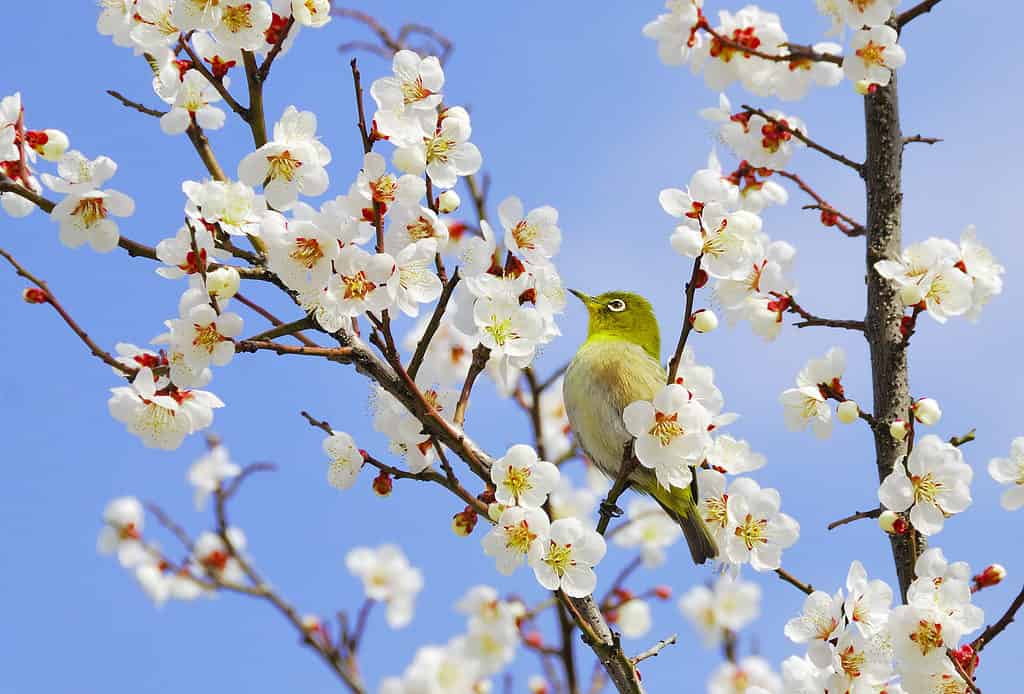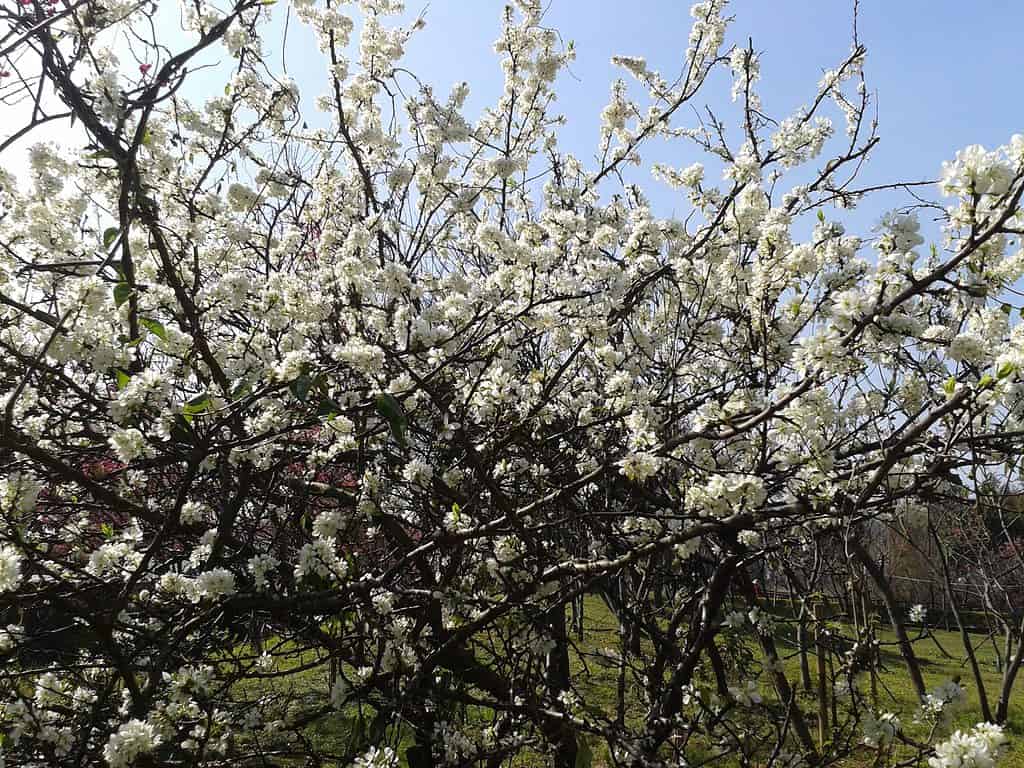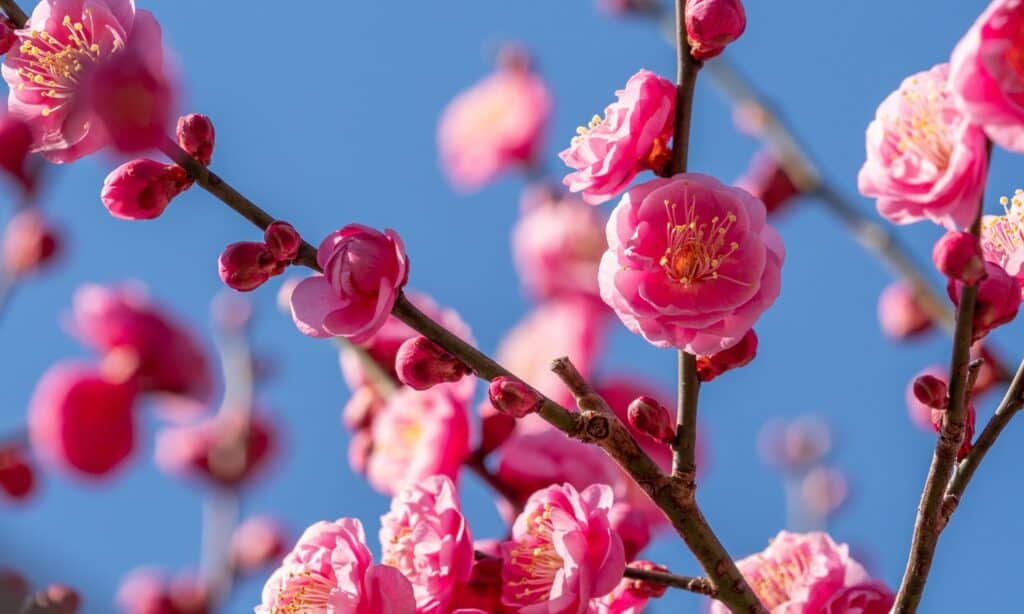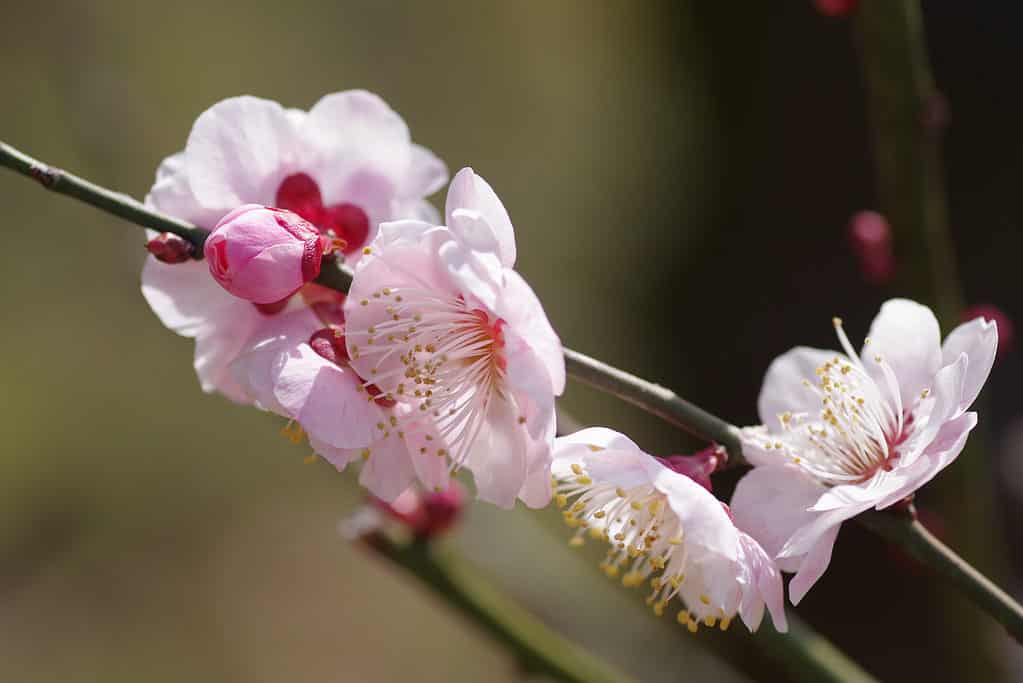Taiwan is famous for its friendly people, delicious street food, and the once-tallest building in the world, Taipei 101. It’s an incredible place to visit and learn about its customs. Let’s discover the national flower of Taiwan, the plum blossom, and learn why it became the country’s floral emblem.
What’s the National Flower of Taiwan?
The national flower of Taiwan is the plum blossom, scientifically called Prunus mei or Prunus memu, but commonly known as Chinese plum, Japanese plum, or Japanese apricot in Europe and the States.
The Republic of China’s Executive Yuan made it the official flower of Taiwan on July 21, 1964.

The national flower of Taiwan is the plum blossom, symbolizing the country’s resiliency.
©Richard Fisher from London, UK, CC BY 2.0 <https://creativecommons.org/licenses/by/2.0>, via Wikimedia Commons – License
Is Taiwan in China?
Taiwan’s official name is The Republic of China. This is not the same as the People’s Republic of China, which refers to mainland China.
Taiwan is located in East Asia, in the northwestern Pacific Ocean. To the northeast is Japan, to the south are the Philippines, and to the northwest is the People’s Republic of China. Taiwan has a lot of Chinese influence because over 97 percent of the population is ethnically Chinese. This is why China and Taiwan have the same national flower.
Half of Taiwan is covered in forest, and at least 90% of the population lives along the east coast! Its capital city is Taipei, and the main language is Mandarin, although many speak English.
Discover Why Plum Blossom Is the National Flower of Taiwan
Plum blossom was first chosen to represent the Chinese people in 1928 and was reaffirmed as Taiwan’s national flower in 1964. The government thought the plum blossom’s ability to endure sub-zero winter temperatures and still blossom in late winter resembled its citizens’ ability to endure hardship.
In addition to its tough yet beautiful traits, the plum blossom has five petals that represent the five main Chinese nationalities (and branches of government) during that period of history: Tibetan, Hui, Mongol, Manchu, and Han.
Plum blossom flowers also have three delicate pollinating stamens at their center that represent Sun Yat-sen’s Three Principles of the People: nationalism, democracy, and livelihood.
But that’s not all!
Plum blossom tree bark, foliage, flowers, and fruits are major components in traditional Chinese medicine. For at least 2,000 years, it has been used for respiratory complaints and everyday illnesses like stomach aches.

Plum blossom tree bark, foliage, flowers, and fruits are a major component in traditional Chinese medicine.
©Foxy Who \(^∀^)/, CC BY-SA 3.0 <https://creativecommons.org/licenses/by-sa/3.0>, via Wikimedia Commons – License
What Does Plum Blossom Look Like?
Plum blossom is a tough flower, so you might assume it’ll look tough too, but plum blossom is a delicate-looking, pretty star-shaped flower.
It blooms in winter (January to February in its native China) on bare branches, so it’s very easy to spot amid a bare winter landscape. Depending on the species, plum blossom is red, pink, or white with thin whiskery stamens. Each flower is around half an inch in diameter, but there are so many on the branches that it’s difficult to see any wood.
Plum blossoms are sweetly scented and a big draw for early-waking pollinators, who rely on their nectar supply to survive harsh weather.
A plum blossom tree can reach 25 feet tall with an upright 25-foot-wide crown of ribbed dark-green leaves. Its leaves appear after the flowers are spent and drop during fall in a curtain of rich yellow shades. Although it’s native to the Yangtze River environment of south China, it’s also established in China, Japan, and Korea.
If you like old trees, there’s a 1,600-year-old plum blossom in China’s Hubei province, which is still flowering after all this time. What a testament to the resilience of plum blossom!

Depending on the species, plum blossom is red, pink, or white with thin whiskery stamens.
©iStock.com/ruiruito
Can You Eat Plum Blossom Fruit?
Plum blossom fruit is edible and very popular in Asia, where it’s turned into pickles, sauces, condiments, and a drink called sour plum juice.
Unlike the plums we buy in stores, plums from Prunus mei are somewhat sour. The sourness pairs up well with sweet flavors such as ice cream and crumble, so it’s still a great addition to a kitchen garden. Just be sure to get a fruiting variety because some Prunus mei cultivars are ornamentals (flowers but no fruits)
Even if you don’t like plum blossom fruits, birds and small mammals do, and the plant’s pollinator-magnet status will ensure that all the pollinators are busy in your yard as soon as they wake up.
Just a quick word of warning here: plum pits (the stones) are toxic to dogs in large quantities, so make sure Rover can’t hoover them up.
When Do Plum Blossoms Flower?
Plum blossom flowers in late winter to early spring. In its native China, this is January to February.
It’s the early blossoming trait that makes plum blossoms appear so resilient, and it is why they were chosen as the national flower of Taiwan.
Is Plum Blossom the Same as Cherry Blossom?
No, plum blossom and cherry blossom are not the same plant. One is a plum tree, and one is a cherry tree!
However, the flowers and growing habits are very similar. Here are two ways to tell them apart before the fruits appear.
| Plum blossom | Cherry blossom |
|---|---|
| Buds are rounded | Buds are oval |
| Petal spiked at the base | Petal spiked at base |
Discover Taiwan’s National Flower: Plum Blossom Growing Guide
Growing plum blossom in your garden is simple. These resilient trees are easy to manage if you can choose the right spot to plant them. Here’s how:
Plum blossom will grow in USDA Zones 4 through 9 and in most of northern Europe. They cope well with the cold but struggle in the tropical heat. If you are determined to have Taiwan’s national flower, the plum blossom adorning a Floridian yard, it’ll need air circulation, shade, and a lot of water.
The first step is to choose a plum blossom because there are 300 cultivars on the market today. Taiwan’s national flower, Prunus mei (Prunus memu), is a native plant that produces fruit.
Some popular cultivars include the pink Prunus mume ‘Kobai,’ the white Prunus mume ‘Omoi-no-mama,’ and the deep rose pink (almost red) Prunus mume ‘Ben-chidori.’ Prunus mume ‘Omoi-no-mai’ is unusual if you love scent almond-scented.

There are 300 cultivars of plum blossom on the market today.
©Chihiro H, CC BY 3.0 <https://creativecommons.org/licenses/by/3.0>, via Wikimedia Commons – License
Now It’s Time to Plant!
Look for a moist but well-drained spot because soggy soil will rot the plum blossom tree’s roots. It should get plenty of sun, or at least partial sun. Fully shaded positions equal no flowers!
Prunus mei is one of the best trees for chalky ground, so don’t worry about alkaline soil. It’ll enjoy the well-drained conditions there.
Another positioning issue is wind. Plum blossom trees are tough in sub-zero temperatures, but they can’t cope with persistent, harsh, cold winds. They just blow the beautiful blooms away.
Choose a well-drained sunny spot with some shelter and bingo; that’s a des-res for plum blossom.
- Dig a hole as deep as the nursery pot but twice as wide
- Put lots of rich organic matter in the planting hole
- Backfill with a mix of rich soil and compost and gently tread it down
- Water it well until you see new growth
- Large plum blossom trees need staking to prevent wind rock
How Much Water Does a Plum Blossom Need?
Trees are pretty self-sufficient, and you might think that because they don’t need watering in the wild, you don’t need to in your garden.
Wait up! This is a mistake.
When you plant a tree (or any plant) in your yard, it will need your care to thrive because that is not its native environment.
All trees drink A LOT of water, and newly planted trees are the thirstiest of all. The best time to plant a plum blossom is in fall when the ground is warm but damp, and there’s a whole lot of winter rain to come.
Once a plum blossom is planted, it needs a can of water every other day to establish its roots. When new growth appears, you can back off a bit, but young trees need water in the hot months, too.
Container-grown plum blossom trees need water and fertilizer several times a week, even daily in hot zones. The number one killer of newly planted trees is lack of water, so don’t be stingy if you want your plum blossom coated in sweetly scented flowers.
The photo featured at the top of this post is © iStock.com/TokioMarineLife
Thank you for reading! Have some feedback for us? Contact the AZ Animals editorial team.






